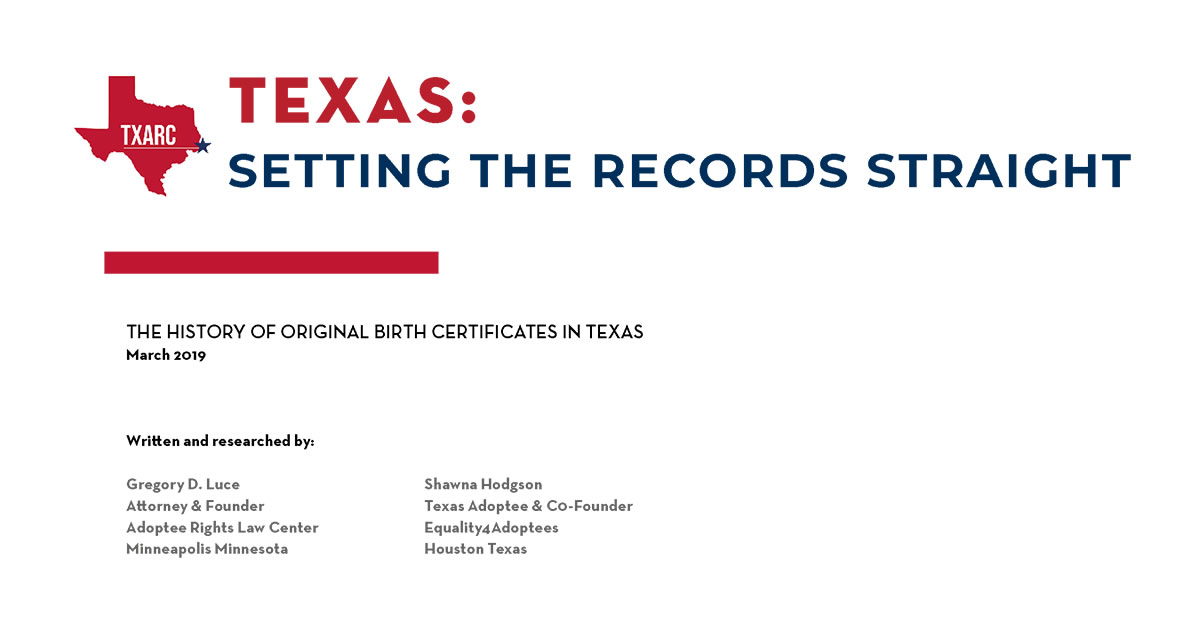 The following are excerpts from a newly-published report, Texas: Setting the Records Straight, released by the Texas Adoptee Rights Coalition in March 2019. The full report is available for reading and downloading here. Printed and electronic copies of the full report are being provided to Texas legislators. Note: this post was originally published on Adoptee Rights Law Center.
The following are excerpts from a newly-published report, Texas: Setting the Records Straight, released by the Texas Adoptee Rights Coalition in March 2019. The full report is available for reading and downloading here. Printed and electronic copies of the full report are being provided to Texas legislators. Note: this post was originally published on Adoptee Rights Law Center.
Summary
It is critical for advocates and legislators to understand Texas legislative history on the how, why, and when of sealed original birth certificates in the state, and especially to understand the difference between a vital government record and more general ‘adoption records.’
Texas first issued new and amended birth certificates for adoptions in 1935, sealing the original birth certificates but providing adoptive parents with a copy of originals as attachments. It was not until 1951 that Texas created its current practice of using a “supplementary” certificate. The original, however, also remained available upon request to the adoptee “if of legal age.” In 1957, Texas sealed all original birth certificates and made them available only by court order, even to the adult adoptee. This was largely in reaction to more than a decade of rampant unlicensed adoptions and trafficking of “adoptable” children in the state.
In 2005, Texas changed the law to provide for the release of an OBC to an adult adoptee if the names of the birthparents listed on the record are known. It does not matter how those names are known, whether through family lore, hiring private investigators, using social media, or submitting your own DNA to AncestryDNA, 23andMe, or any of numerous consumer DNA testing companies.
Current law creates different classes of adoptees, some with more rights than others. Yet all Texas adoptees are denied a right all other Texans have: to have their own original birth certificate and to know their full Texas heritage.
Understanding Texas Law: A Timeline
1850Shortly after becoming a state, Texas enacts a law in 1850 that provides for the adoption of “legal heirs.” The law relates primarily to inheritance rights of adoptees. Adoptions are treated and filed in the same manner as deed transfers for property.
1907Additional provisions for Texas adoption law are added but court involvement is not required other than to terminate an adoptive parent’s custody if the parent is deemed abusive. The new law in also prohibits transracial adoption, stating that “[n]o white child can be adopted by a negro person, nor can a negro child be adopted by a white person.”
1931Texas modernizes its adoption law for the first time, requiring court approval of adoptions and ratifying prior adoptions that had been done without court involvement. While the new law makes court records confidential, the records remain available to the parties and the parties’ attorneys.
1935The state, for the first time, enacts legislation that provides authority to seal original birth certificates after adoption, legitimation, or paternity determinations. An amended certificate is then issued, which is attached to the original and is available upon request to adoptive parents. Otherwise, the OBC is not available except by court order.
1943Texas law is clarified to provide that adoptive parents may request and retain the original birth certificate along with the amended, which are attached to each other.
Acts 1943, 48th Leg., ch. 184, § 1
House Bill No. 628
*****
Section 1. . . . the State Registrar, upon the written request signed by the parent, or parents, of the adopted child, may retain the certificate of the natural birth in the file and may attach a certificate showing the names of the parent, or parents, by adoption to the original certificate as an amendment. The State Registrar shall furnish the Local Registrar with a copy of the said birth certificate to be attached to the original birth certificate.
1947Stories of rampant black market adoptions and unlicensed agencies in Texas dominate the news and grab legislative attention. Of the approximately 5,000 adoptions handled in the state each year, about 70 percent had been completed through unaccredited agencies. According to spokespersons with the Department of Public Welfare at the time “baby selling goes on in one form or another throughout the state,” estimating that most babies “sold” for $2,000. The legislature passes new and controversial laws to allow the state to more aggressively regulate adoptions, including being given access to previously confidential information. Secrecy in records had led to these notorious abuses.
1951In response to continued issues of child trafficking and unlicensed adoptions, Texas creates the “supplementary certificate,” an amended birth certificate that is issued after legitimation, paternity determinations, and adoptions. The OBC is sealed after issuance of a supplementary certificate but is still made available to the adoptee upon request when “of legal age.”
Acts 1951, 52nd Leg., ch. 223, § 1
House Bill No. 244
******
The preparation and filing of supplementary certificates of birth based on legitimation, paternity determination, and adoption shall be in accordance with the regulations of the State Department of Health. Provided, however, that when a child is adopted the new birth certificate shall be in the names of the parents by adoption, and the copies of birth certificates or birth records made therefrom shall not disclose the child to be adopted. After the supplementary certificate is filed, any information disclosed from the record shall be made from the supplementary certificate, and access to the original certificate of birth and to the documents filed upon which the supplementary certificate is based shall be authorized upon the request of the person, if of legal age, his legal representative or upon order of a court of competent jurisdiction.
1957For the first time, Texas law seals original birth certificates related to illegitimacy and adoption and makes the OBC available only by court order, even to adult adoptees later. Legislators justify the change because “present law does not adequately prohibit unauthorized disclosures of lllegitimacy, legitimation, paternity determination, and adoption.” The new law is effective May 20, 1957.
1974The legislature creates the Central Record File, which consolidates files from the court in cases involving the parent-child relationship. For adoptions, the court transmits the complete file in the case to the Department of Public Welfare, and upon receipt the records are closed and made unvailable except by court order. This process does not involve any change in the processing of vital records. The law becomes effective January 1, 1974.
1984Texas creates the “Central Adoption Registry,” a mutual consent adoption registry that adoptees, siblings, and birthparents may voluntarily use as a means to find and contact each other. It requires mandatory counseling of at least one hour and has been woefully inefficient for its purpose, with few people actually using it or finding it useful. It is no different than other mutual consent registries across the country. It became effective on January 1, 1984.
2005Beginning in September 2005, adoptees at the age of 18 may apply for the OBC and, if he or she knows the identity of the parent(s) named on the record, the vital statistics unit must release a noncertified copy of the original birth certificate. It does not matter how the names are known nor are any birthparents notified of the adoptee’s request.
Conclusion
Sealing birth certificates and making them unavailable even to an adult adoptee was never about birth parent confidentiality. Rather, it was intended to strengthen the relationship between the adoptee and adoptive parents by eliminating potential interference from birth parents. By eliminating any reference to adoption, it was also intended to reduce the “stigma” that was once associated with being “illegitimate” or adopted. As that stigma has lessened and as adoptees obviously become adults, the purpose of making an OBC unavailable to an adult adoptee is no longer warranted. Accordingly, keeping an OBC inaccessible to an adult adoptee makes little sense. It also discriminates against an entire class of Texans.


 The Texas Adoptee Rights Coalition is a coalition of Texas and national organizations working to secure the right of all Texas adult adoptees to obtain their own original birth certificates, without discriminatory restrictions.
The Texas Adoptee Rights Coalition is a coalition of Texas and national organizations working to secure the right of all Texas adult adoptees to obtain their own original birth certificates, without discriminatory restrictions.